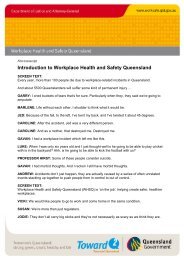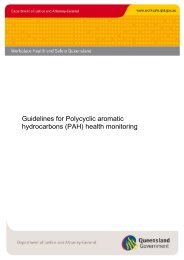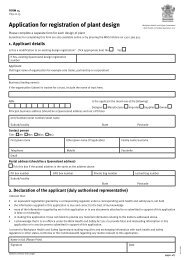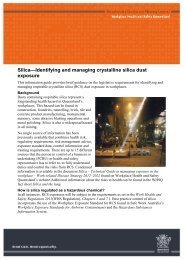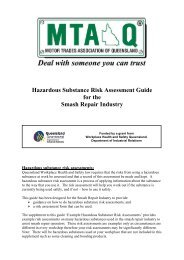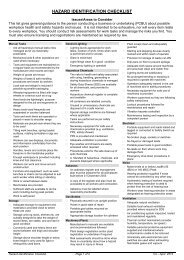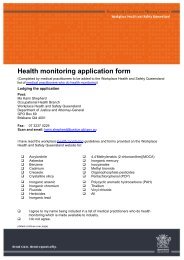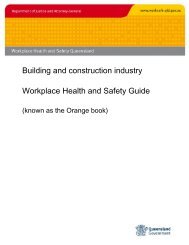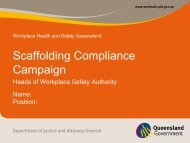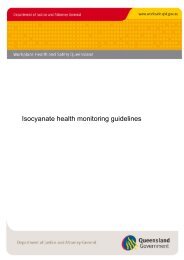A guide to the Dangerous Goods Safety Management Act 2001
A guide to the Dangerous Goods Safety Management Act 2001
A guide to the Dangerous Goods Safety Management Act 2001
Create successful ePaper yourself
Turn your PDF publications into a flip-book with our unique Google optimized e-Paper software.
6.5.2 Material <strong>Safety</strong> Data Sheets<br />
A Material <strong>Safety</strong> Data Sheet must be obtained for every type of <strong>the</strong> dangerous goods <strong>to</strong> be s<strong>to</strong>red or<br />
handled at <strong>the</strong> DGL, and a copy kept close <strong>to</strong> where <strong>the</strong> goods are s<strong>to</strong>red.<br />
6.5.3 Placarding<br />
A DGL must erect placards (warning signs) at specified locations <strong>to</strong> provide information about <strong>the</strong><br />
presence and nature of <strong>the</strong> dangerous goods at <strong>the</strong> location.<br />
For more detailed information on Placarding, <strong>the</strong> CHEM Unit’s Information Paper No 15 - Placarding<br />
for <strong>Dangerous</strong> <strong>Goods</strong> S<strong>to</strong>rage under <strong>the</strong> DGSM <strong>Act</strong> - is available on <strong>the</strong> CHEM Unit’s web page<br />
(http://www.emergency.qld.gov.au).<br />
6.5.4 Register<br />
An occupier must maintain a register listing all dangerous goods and combustible liquids s<strong>to</strong>red or<br />
handled at a DGL.<br />
The register must contain a Material <strong>Safety</strong> Data Sheet for each of <strong>the</strong> stated dangerous goods, and<br />
must be readily accessible <strong>to</strong> everyone at <strong>the</strong> DGL.<br />
6.5.5 Emergency Plans and Procedures<br />
Emergency plans and procedures must be established at large DGLs, maintained, documented, reviewed<br />
and updated in consultation with employees, neighbours and <strong>the</strong> emergency services.<br />
The plans must include strategies <strong>to</strong>:<br />
• contain and control a major accident;<br />
• minimise off-site impacts; and<br />
• protect people, property and <strong>the</strong> environment in <strong>the</strong> event of a major accident.<br />
The plans and procedures must include <strong>the</strong> following details for <strong>the</strong> premises:<br />
• <strong>the</strong> identity of dangerous goods and combustible liquids s<strong>to</strong>red or handled and <strong>the</strong> types of<br />
potential emergencies <strong>the</strong>y may cause;<br />
• <strong>the</strong> organisational structure, <strong>the</strong> resources and equipment, and <strong>the</strong> procedures for dealing with<br />
a hazardous materials emergency;<br />
• <strong>the</strong> site layout showing <strong>the</strong> locations of hazardous materials and of emergency resources and<br />
equipment; and<br />
• emergency contact details.<br />
6.5.6 Manifests<br />
A manifest of dangerous goods s<strong>to</strong>red at a large DGL must be kept readily available for <strong>the</strong> emergency<br />
services. The principal purpose of an emergency manifest is <strong>to</strong> inform <strong>the</strong> fire authority and o<strong>the</strong>r<br />
emergency services of <strong>the</strong> type, quantities and locations of dangerous goods s<strong>to</strong>red on <strong>the</strong> premises.<br />
For more detailed information on Manifests, <strong>the</strong> CHEM Unit’s Information Paper No 16 - Manifests<br />
for <strong>Dangerous</strong> <strong>Goods</strong> S<strong>to</strong>rage under <strong>the</strong> DGSM <strong>Act</strong> - is available on <strong>the</strong> CHEM Unit’s web page<br />
(http://www.emergency.qld.gov.au).<br />
19





